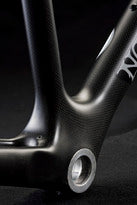So the Wheelhouse frames are in, and a bunch of them are already built up ready for angry pedal turning this weekend. In addition to all the pre-orders, we took some additional inventory in the most popular sizes to meet our MOQ (that's bike-company for Minimum Order Quantity, the only acronym we use around here, except possibly ASAP). We've since sold out of size 6 (57.5cm top tube) but have a handful of size 3, 4 and 5 frames left (top tubes of 53.5, 54.5 and 56.0 respectively) for immediate delivery. We put up a gallery of the frame on Facebook if you'd like to see more.
When we chose this frame, we expressly elected not to go superlight. We looked at frames in the 950g range, which is about 200g heavier than a medium-sized Wheelhouse. We know lightweight frames have a lot of appeal in the market, but we wanted stiffness, reliability, stiffness, efficient power transfer, and stiffness. I read in one of the trade pubs recently about the role that pros play in frame product development. The gist of the article was that when you put a pro cyclist on a bike and ask him how to improve it, the unequivocal response is, "make it stiffer." So we took that pro cyclist advice without having to tender the pro sponsorship budget. The Wheelhouse is a stiff bike.
 To wit, look at its massively overbuilt bottom bracket. There's enough carbon fiber in there a bottom bracket and a half, and if this were any other bike company we'd try to give it a proprietary name like BB1.5(tm). To be clear, we're not engineers and we didn't spec the bike this way - the intensely smart people who make their living designing and building racing bicycle frames at our supplier did it. What we did was choose the bike that already had the characteristics (ie, stiffness) that we sought.
To wit, look at its massively overbuilt bottom bracket. There's enough carbon fiber in there a bottom bracket and a half, and if this were any other bike company we'd try to give it a proprietary name like BB1.5(tm). To be clear, we're not engineers and we didn't spec the bike this way - the intensely smart people who make their living designing and building racing bicycle frames at our supplier did it. What we did was choose the bike that already had the characteristics (ie, stiffness) that we sought.
The head-tube is similarly muscular. It almost looks like it has a frame gusset like the BMX bikes I used to race. If we were focused on an extremely light weight frame, this remarkable stiffness in the bottom bracket and head tube would either need to be compromised, or else achieved with some truly innovative and expensive technology and process, the result of which would either be a bike that doesn't transfer your power as efficiently, or that costs a hella lot more than 945 bones.
 Even though we don't stress out over weight, we did of course want to know how much the different sized Wheelhouse frames weighed. A size 2 (52.5cm top tube) came in right at 1100g, a 5(56) was 1170, and a 7 (59.5) was 1237g. That's not a ton of weight variation for frames sized to fit riders ranging from about 5'3" through 6'4". What it suggests, in fact, is that the frames' weight is concentrated in the parts of the bike that are the same no matter which size - particularly the BB and chain stays, and then the gusset-like junction of the headtube with the top tube and seat tube. (I say "suggests" because I'm not about to cut one into component pieces and weigh them.)
Even though we don't stress out over weight, we did of course want to know how much the different sized Wheelhouse frames weighed. A size 2 (52.5cm top tube) came in right at 1100g, a 5(56) was 1170, and a 7 (59.5) was 1237g. That's not a ton of weight variation for frames sized to fit riders ranging from about 5'3" through 6'4". What it suggests, in fact, is that the frames' weight is concentrated in the parts of the bike that are the same no matter which size - particularly the BB and chain stays, and then the gusset-like junction of the headtube with the top tube and seat tube. (I say "suggests" because I'm not about to cut one into component pieces and weigh them.)
The point is that if you're a dyed-in-the-wool weight weenie, please move along - there's nothing to see here. But if you've worked hard to develop your power and make the not unreasonable request that as much of it as possible actually go into propelling you forward, then you may just be glad for the Wheelhouse's strategic heft.

4 comments
IT A GOO LOOKIGN BIKES I WISHIGN I CAN HALF ONE BUT I NEEDIGN A MORE ALLOWENTS!!!!
TRY SELLIGN THE WATTER BOTTELL!!!!!
BUT THAN WHAT WUOLD I DRINKIGN A WATERS AND NUUNS FORM???
I got my frameset yesterday, I can't imagine anything being lighter than the Wheelhouse. But then again I'm a mountain biker, and 5 lb frames and 1600+ gram forks are the norm…